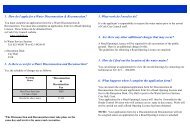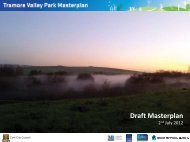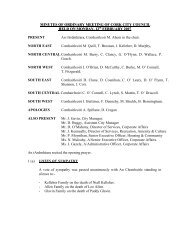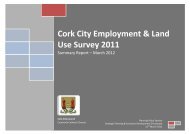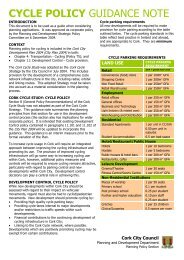Untitled - Cork City Council
Untitled - Cork City Council
Untitled - Cork City Council
Create successful ePaper yourself
Turn your PDF publications into a flip-book with our unique Google optimized e-Paper software.
Appendix 1 : Population projections for retail zones<br />
1. Introduction<br />
This appendix sets out the methodology used in the projection of population to specified<br />
years between 2002 and 2020, for defined retail zones in the <strong>City</strong> and County of <strong>Cork</strong>.<br />
The methodology is based on a top-down allocation of target population growth for the<br />
South West Region, as set out in directions to Regional and Local Authorities from the<br />
DEHLG.<br />
In overview, the steps in the projection process are as follows:<br />
1. Planned regional population growth is allocated to the Counties of <strong>Cork</strong> and Kerry<br />
and the <strong>City</strong> of <strong>Cork</strong>, in accordance with criteria set out in section 2 below and agreed<br />
with the SWRA;<br />
2. Population growth within the functional area of <strong>Cork</strong> County is divided between the<br />
Metropolitan Area, Mallow Hub, remainder of the CASP Area and the remainder of<br />
the County, in accordance with criteria set out in section 3 below;<br />
3. Population growth in the defined retail zones (see main report for map) is calculated<br />
by:<br />
• Assuming that the population growth rate in a particular Electoral Division within<br />
any given retail zone will accord with growth rates defined for the CASP zone<br />
within which the ED lies (for those lying in the CASP area) or the growth rate for<br />
the remainder of the County (for those lying outside the CASP area);<br />
• Adding the resultant projected populations of all EDs in the given retail zone to<br />
obtain a total for the said retail zone.<br />
2. Allocate regional targets to Counties within the Region<br />
Approach used<br />
The overall approach that has been used to obtain results at county level, is as follows:<br />
1. The growth potential of County Kerry is assessed, within the context of the overall<br />
regional target, bearing in mind previous performance in terms of relative growth<br />
rates and the provisions of the 2006 Tralee/Killarney Hub Settlement Local Area Plan<br />
1 ;<br />
2. The capacity of the <strong>City</strong> of <strong>Cork</strong> to absorb additional population is assessed, based<br />
on the known amount of developable land using suitable development densities, and<br />
the projected fall in the occupancy of existing households;<br />
3. The remaining population is allocated to County <strong>Cork</strong>.<br />
County Kerry<br />
Details of the derivation of the Kerry population projection are contained in a paper<br />
submitted to the South West Regional Authority. 2<br />
It is assumed that Kerry will take the share of the population increase that it enjoyed in<br />
the period 2002 to 2006. This was 18.1 per cent and would result, based on the change<br />
projected for the period 2002 to 2020, in a population of 176,000 in 2020,<br />
There is an on-going policy commitment to the development of Gateways and hubs, and<br />
the predominance of <strong>Cork</strong> in the share of these is great. <strong>Cork</strong> had 88 per cent of the<br />
1 Tralee/Killarney Hub Settlements Local Area Plan Planning Policy Unit, Kerry County <strong>Council</strong>,<br />
December 2006<br />
2 Distribution of target 2020 Regional Population in the South West Region Working paper produced<br />
by Jonathan Blackwell for the South West Regional Authority – July 2007<br />
1



